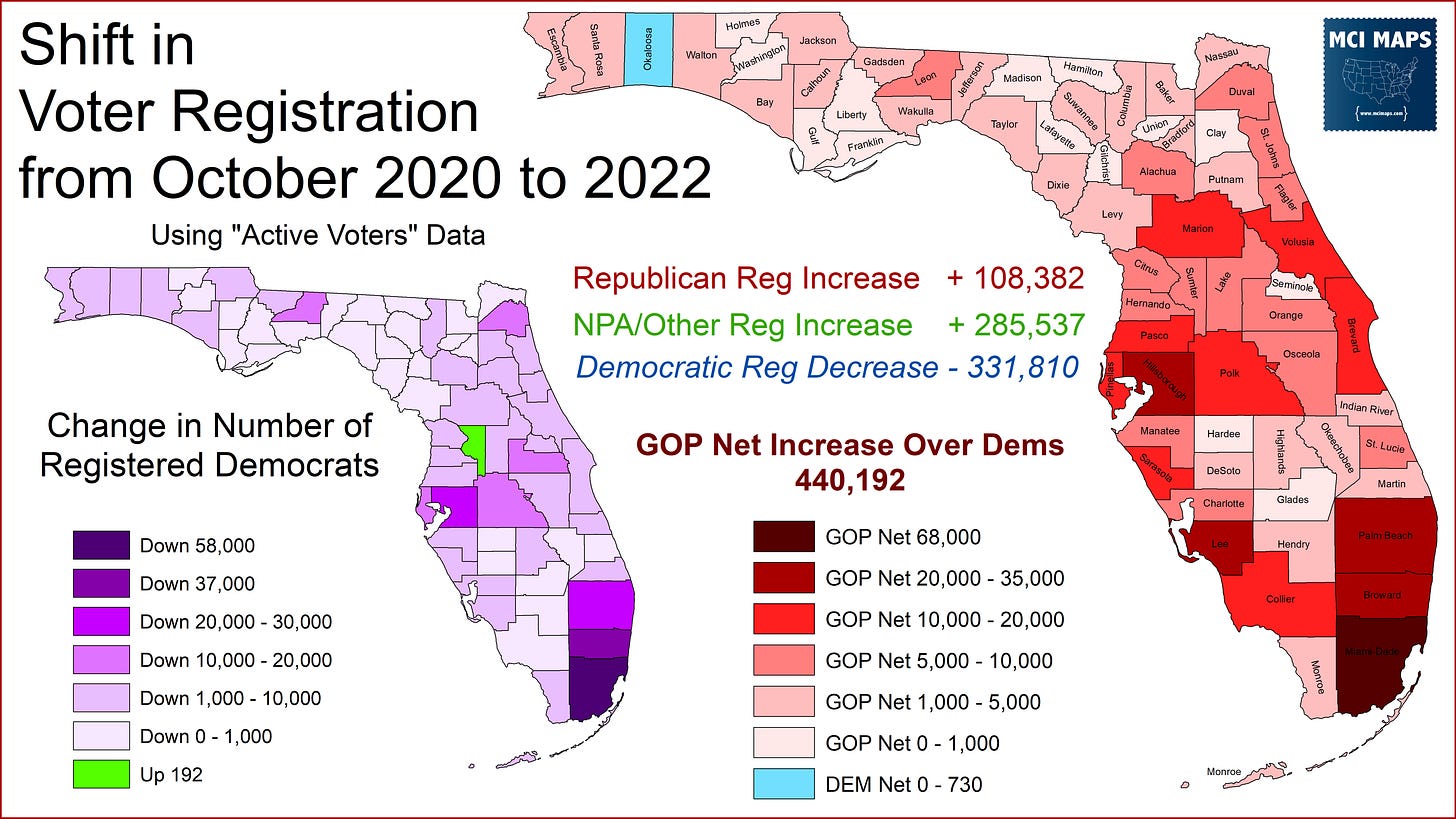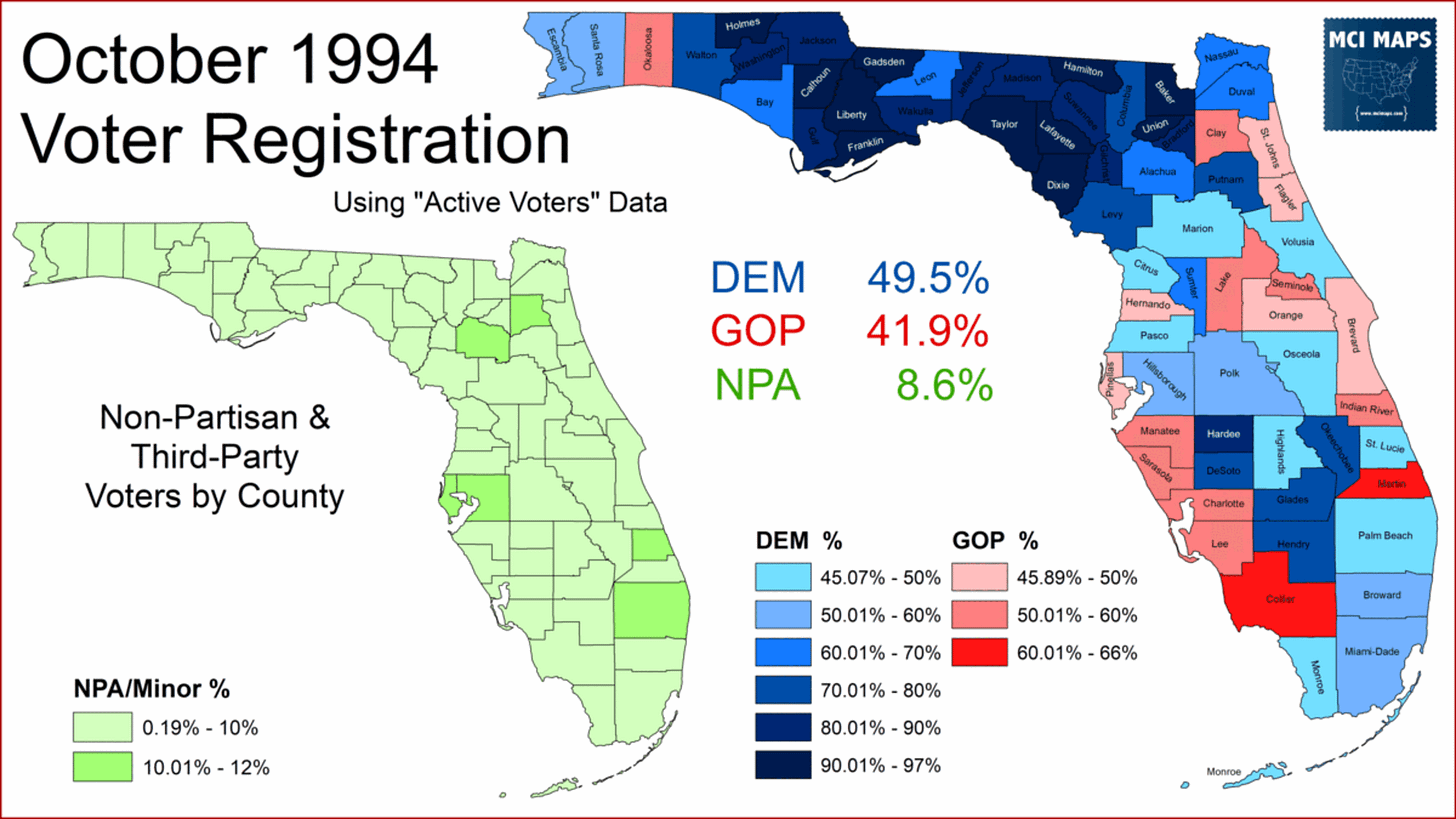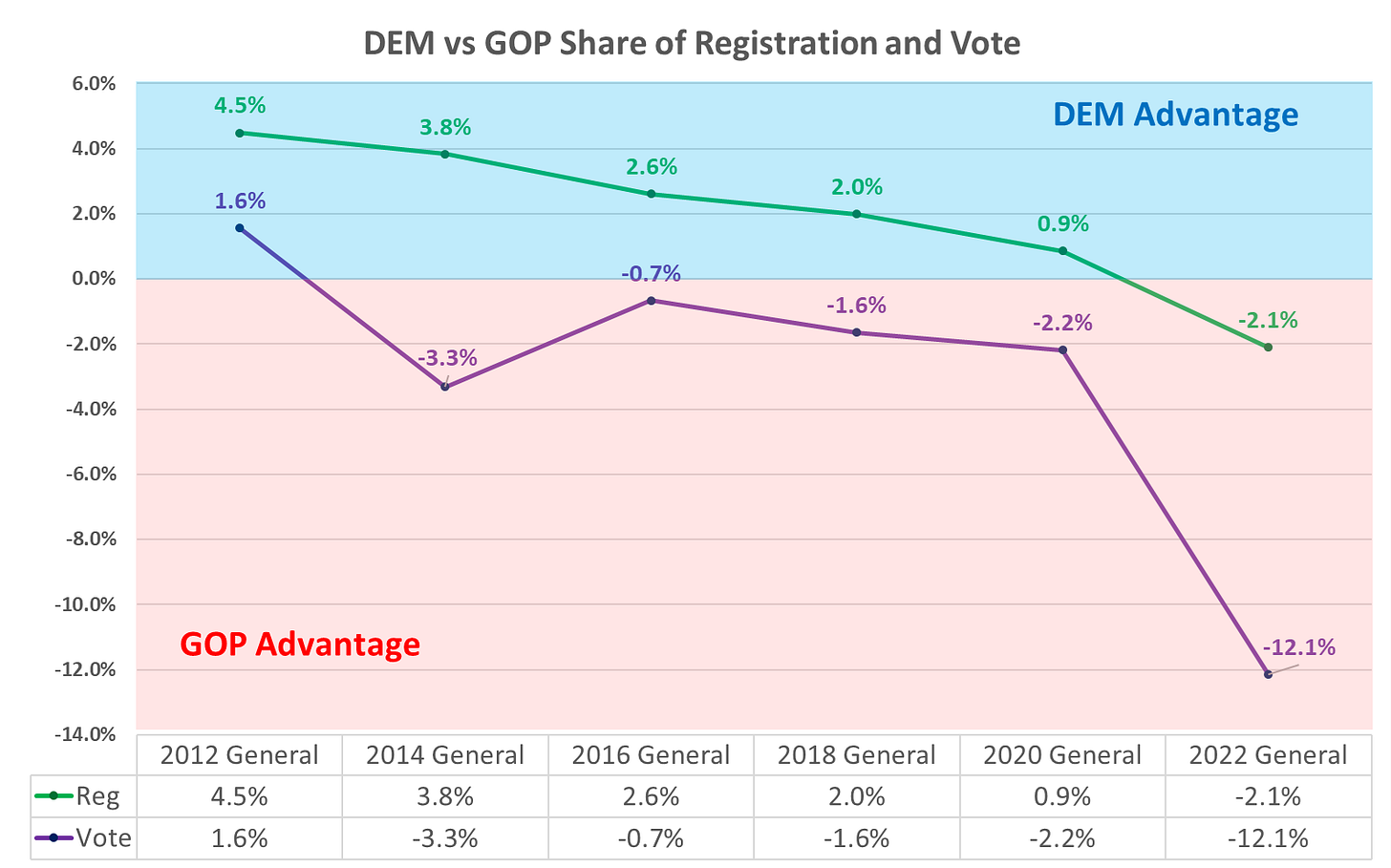Issue #81: The Insane GOP Turnout Advantage in Florida
There has never been such a gap in partisan turnout
As I already covered in Thursday’s substack post, Democrats in the state of Florida faced a massive wipeout. Statewide races went 15-20 points to the GOP, and Democrats lost a large number of state lawmakers from districts that usually were solidly Democratic. What was clear from the early voting data, and from election day itself, was that Republicans were FAR outpacing Democrats in turnout. I now have the final partisan turnout data, so I wanted to go through some of these numbers and give some context on how lopsided this year was.
Warning Signs
The massive turnout disparity was foretold when the the final registration figures came out several weeks ago. The 2022 midterm was historic for many reasons, the first being that it was the first general election held in Florida when Republicans led in voter registration.
When comparing the registration figures to those just two years ago, the problem was clear. While Republicans and independents had increased their voter rolls by hundreds of thousands, Democrats were DOWN 300,000.
Every cycle, the voter rolls are purged for people who died or moved. Each party loses voters, but more often than not, new registration makes up the difference and them some. Democrats, however, had no major voter registration program in place to register voters.
There are also, of course, party registration changes voters decide to make themselves.
This was not especially surprising, as I talked about on Thursday, the Democratic Party had few resources. Republicans, meanwhile, had been engaging in massive Voter Registration drives for years. The GOP gains in voter reg in 2020 alone were what led to my decision to say Trump would win the state that year. The resource disparity, which was the worst this year but has been bad for some time, allowed the GOP to continuously engage and recruit voters, while Democrats could not keep up.
The history of voter registration in Florida can be seen below. I delved into this history much more in a substack from before the election.
You can also read here about how the end of the North Florida Democratic dominance will lead to the end of protest votes in Dem primaries.
Bottom line, the registration changes pointed to the resource disparity going on in Florida. This was only naturally going to translate into voter turnout.
Looking at the Turnout
Turnout in the 2022 midterm was 53.5%. This was notably lower than 2018; when turnout topped 62%. The 2018 midterm was a historic high that was unlikely to be matched; especially with Democrats lagging. Turnout % was down in all but four counties; with it worst in Orange.
The biggest turnout drops were almost all Democratic regions. The most notable urban county drop was Lee; which is a GOP stronghold. Why did their turnout drop? It is almost surely the effects of Hurricane Ian, which smashed into the Fort Meyers region as a Category 4 just one month ago. The flooding and damage to the region led to Lee County having to take extraordinary actions to hold its elections. This included mega polling locations and a quick attempt to get absentees to people displaced. Even with these efforts, it was widely expected turnout would be down in that region.
Another example of Hurricane effects - the increased turnout in Bay, Calhoun, and Gulf can all be attributed to their lower turnout in 2018. Why was it lower then? Because weeks before the 2018 midterm, Hurricane Michael slammed into the Panama City region as a category 5. The effects were so bad that even in 2020, the damage was still clear; with several ravaged areas showing lower voter totals since 2016.
Hurricane effects on turnout are not responsive for the partisan balance, however.
The Partisan Gap
We do not yet have the final voter lists of who cast ballots. Once those come out, further analysis by age, race, and voting history will be possible (and you bet I will be breaking all that down). What we do have, for the moment, is turnout by party. I managed to snag all this data from the individual county turnout trackers. Incredibly tedious. Also prone to human error, so these are unofficial.
The final figures show the Republicans made up 45% of the votes cast while Democrats made up just 33%. GOP turnout was 67% vs 52% for the Democrats. A staggering turnout gap of 14.8%!!!
Every county saw higher Republican turnout. The best county for Democrats was Monroe, where they only lagged by 4%. Meanwhile, in Lafayette, the turnout gap was 28%!
Traditionally blue counties like Palm and Osceola barely had more Democrats casting ballots, which allowed the GOP to flip both with a major push for independents. Republicans outpaced Democrats in votes cast in Hillsborough and Miami-Dade, allowing them to flip those counties as well. There was no good story for Democrats in any county.
Turnout among independents was only 38.6% of the vote, leaving an electorate much more partisan than the registration.
Compared to past cycles, this turnout gap is unprecedented. Before this week, the worst modern turnout gap was a 10% GOP advantage in 2014; a red wave midterm.
The table above highlights the effect of Barack Obama’s massive Organizing for American field program. That was the last year Democrats led in votes cast, and kept the turnout gap the closest it has been all decade - which was still a 6% GOP advantage. That Republicans have better turnout is not new. What is new is such a massive gap.
The line graph below shows the Dem vs GOP gap (with a positive number being D advantage) for both registration and votes cast. While voter registration has been slowing sliding for Democrats for some time, the gap in share of votes cast has jutted around more. After losing ground in 2010, Democrats were almost able to come to parity with Republicans in 2016. Things slid slowly toward the GOP over the next two cycles, then fell off a cliff in 2022.
It is a collapse far greater than I think most could have imagined. Granted, the GOP operatives working their field program likely knew it was coming.
Now as I said before, once we get the final voter lists, analysis by other demographics will be possible. One data point we do have at the moment is the absentee ballot return data. I broke down the absentee ballot requests and returns by party and race. This data, which again only accounts for one voting method, does reveal a few critical notes.
African-American ballot returns lagged white voters.
Hispanic Democrats lagged Hispanic Republicans - a gap notably worse in key counties.
Independents overall were less engaged and returned fewer ballots.
Now, anyone who requested a ballot but decided to vote on election day or in early voting would have been able to do so, so that should be kept in mind. This return rate breakdown is more to just offer a preview of the further analysis that will be performed.
A full Spreadsheet of the 2022 Turnout by County is Here
Feel free to play around in the spreadsheet linked above, where I have the county and party turnout data.
That’s all for now.













Governor DeStantis ordered supervisors of elections for all Florida counties to remove registered Democrats from the active voters category if they had not voted in the previous four years. I don't know how many counties did that but that was when the number of active registered Democrats went below the number of registered Republicans.
More great stuff. Thanks!